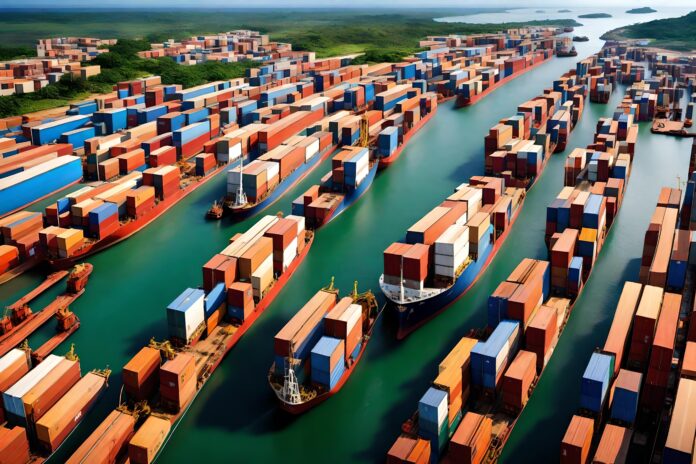Export Industries in Sri Lanka: Driving Economic Growth
Introduction
Export industries play a crucial role in Sri Lanka’s economy, contributing significantly to economic growth and development. The country’s rich history and strategic location have made it a hub for various export sectors. This article dives into the diverse industries that drive Sri Lanka’s economic growth, their historical context, key sectors, factors driving export growth, challenges faced, initiatives and support systems, socio-economic impact, and future opportunities.
Historical Context
Sri Lanka’s export industry has evolved over the years, adapting to changing global demand and market dynamics. The country’s strategic location along major trade routes has allowed it to establish itself as a trading nation. From its early days as a producer of commodities such as spices and tea, Sri Lanka has expanded its export portfolio to include a diverse range of products and services. This evolution in the export industry has been instrumental in driving Sri Lanka’s economic development and improving its standing in the global market.
Key Export Sectors in Sri Lanka
Products
3.1 Apparel & Textiles – From Humble Beginnings to Success

The apparel and textiles sector in Sri Lanka has grown exponentially over the years, playing a crucial role in the country’s export industry. From humble beginnings, Sri Lanka has emerged as a major player in the global apparel market, known for its quality manufacturing and innovative designs. The sector provides employment opportunities to a large number of Sri Lankans, particularly women, contributing to income generation and poverty reduction.
3.2 Boat and Shipbuilding
Sri Lanka’s boat and shipbuilding industry has shown significant growth due to its skilled craftsmanship and favorable coastal location. The sector caters to both domestic and international demand, with Sri Lankan boats and ships gaining recognition for their quality and durability. The industry not only supports the export market but also contributes to the country’s tourism sector, attracting boat enthusiasts and offering employment opportunities in coastal regions.
3.3 Ceylon Tea – Historical Significance and Current Trends

Ceylon tea holds historical significance for Sri Lanka, with the country being renowned for its tea production. Sri Lanka’s tea industry has a strong global presence, emphasizing quality and sustainability. Owing to its distinct flavor and high export demand, Ceylon tea has become a significant contributor to Sri Lanka’s economy, generating valuable foreign exchange earnings and employment opportunities in tea-growing regions.
3.4 Coconut and Coconut-based Products

Sri Lanka’s abundant coconut resources have led to the development of a thriving coconut industry. From coconut oil to coconut coir, Sri Lanka exports a wide range of coconut-based products, catering to both the food and non-food sectors. The industry not only drives economic growth but also contributes to sustainable agricultural practices and harnesses the full potential of coconut resources.
3.5 Diamonds, Gems, and Jewelry – Leveraging Sri Lanka’s Abundance

Sri Lanka has been known for its precious gemstones for centuries, including renowned Ceylon sapphires. The gems and jewelry industry has played a significant role in Sri Lanka’s export industry, leveraging the country’s abundance of gem resources. The sector encompasses gem mining, cutting, and jewelry manufacturing, contributing to foreign exchange earnings and attracting international buyers to Sri Lanka’s gem markets.
3.6 Food, Feed, and Beverages
Sri Lanka’s export industry also encompasses a diverse range of food, feed, and beverage products. From spices and tropical fruits to processed food items, the country offers a delightful selection of culinary treats. Known for their exotic flavors, Sri Lankan food products have gained popularity worldwide, capturing the hearts and taste buds of food enthusiasts. The country’s commitment to sustainable farming practices and adherence to stringent quality standards have further boosted its reputation in the global market.
3.7 Rubber and Rubber-based Products

Sri Lanka has a long-standing history of rubber production and exports. Rubber-based products such as tires, latex products, and industrial components have been well-received by international buyers due to their durability and superior quality.
3.8 Spices, Essential Oils, Oleoresins
Sri Lanka is globally recognized for its aromatic spices, including cinnamon, pepper, and cardamom. The country’s export of essential oils and oleoresins derived from these spices has gained prominence due to their therapeutic properties and use in the pharmaceutical and cosmetic industries.
3.9 Ayurvedic and Herbal Products
In the lush landscapes of Sri Lanka, a treasure trove of Ayurvedic and herbal wonders awaits. With a legacy steeped in ancient healing traditions, this tropical paradise has become a hub for exporting its natural remedies to the world. From aromatic essential oils to rejuvenating herbal supplements, Sri Lanka’s Ayurvedic and herbal products captivate global markets with their purity, authenticity, and profound therapeutic benefits. Embark on a journey to unlock nature’s secrets and embrace holistic well-being with Sri Lanka’s finest exports.
3.10 Ceramics and Porcelain Products
Sri Lanka’s rich heritage in ceramics and porcelain craftsmanship is reflected in its export industry. From exquisite tableware to decorative pottery, Sri Lankan ceramics and porcelain products showcase intricate designs and superior quality. The country’s artisans combine traditional techniques with contemporary design elements, making Sri Lanka a destination for unique and elegant ceramic exports.
3.11 Chemical and Plastic Products
Nestled amidst the vibrant landscapes of Sri Lanka lies a realm of innovation and sustainability in the realm of chemical and plastic products. Combining cutting-edge technology with a deep commitment to eco-friendly practices, Sri Lanka’s chemical and plastic industry stands at the forefront of global excellence. From high-quality polymers to advanced packaging solutions, these products epitomize durability, functionality, and environmental consciousness. Discover the pinnacle of ingenuity as Sri Lanka redefines the possibilities of chemical and plastic manufacturing.
3.12 Cut Flowers and Foliage
Sri Lanka’s favorable climate conditions and expertise in horticulture have made it an ideal destination for cut flower production.
The export of vibrant flowers and foliage to international markets has gained momentum, thanks to the country’s commitment to sustainable farming practices and adherence to strict quality control measures.
3.13 Engineering Products
Sri Lanka’s engineering sector has shown remarkable growth, contributing to the export of machinery, equipment, and precision-engineered components.
The country’s skilled labor force, technological know-how, and cost competitiveness have been instrumental in attracting international buyers and nurturing a thriving export industry.
3.14 Fish and Fisheries Products
Embark on a journey through Sri Lanka’s thriving fish and fisheries export industry, where the flavors of the sea captivate the world. With meticulous attention to quality and sustainability, Sri Lanka offers a diverse range of pristine seafood delicacies and innovative fish-based products. From succulent prawns to delectable canned fish, these exports showcase the nation’s commitment to excellence, ensuring that every bite delivers an unforgettable taste of the ocean’s finest offerings.
3.15 Footwear and Parts
The footwear and parts industry in Sri Lanka has exhibited significant growth over the years, driven by its expert craftsmanship and utilization of advanced technologies.
3.16 Fruits, Nuts, and Vegetables
Prepare to tantalize your taste buds as Sri Lanka takes you on a remarkable gastronomic journey with its exported fruits, nuts, and vegetable products. From succulent tropical fruits bursting with juicy sweetness to premium quality nuts packed with wholesome goodness, and a cornucopia of farm-fresh vegetables, each product is a testament to Sri Lanka’s commitment to excellence. Indulge in the finest flavors and nourish your body with the bounty of nature from this tropical paradise.
3.17 Giftware and Toys
The giftware and toys sector in Sri Lanka excels in the production of unique, handcrafted items that showcase the country’s rich cultural heritage.
These intricately designed products, including wooden handicrafts, ceramics, and plush toys, have gained international recognition, contributing to the country’s export revenue.
Sri Lanka’s giftware and toy industry offers a wide variety of products that reflect the country’s rich cultural heritage and craftsmanship.
Sri Lankan artisans skillfully craft giftware items, including wooden carvings, handwoven textiles, and traditional crafts.
Sri Lankan toys are known for their creativity, eco-friendliness, and adherence to international safety standards.
3.18 Handloom Products
Handloom products, including textiles and garments, hold a prominent place in Sri Lanka’s export industry.
Handloom weaving is an age-old tradition in Sri Lanka, producing exquisite textiles and garments.
Sri Lankan handloom products showcase intricate designs and vibrant colors, reflecting the country’s rich cultural heritage.
Handloom textiles, including sarees and sarongs, are popular exports from Sri Lanka.
3.19 Leather Products
Enter a world of refined craftsmanship as Sri Lanka unveils its exquisite range of exported leather products. Meticulously curated with attention to detail, each piece embodies elegance, durability, and timeless style. From supple leather accessories to luxurious footwear and finely crafted leather goods, Sri Lanka showcases its mastery in the art of leather craftsmanship. Experience the epitome of sophistication as you embrace the allure of Sri Lanka’s exported leather products, a true testament to the fusion of artistry and quality.
3.20 Light Engineering Products
The light engineering industry of Sri Lanka encompasses a wide range of products, including electrical appliances, automotive components, and precision instruments.
The country’s skilled workforce and advanced manufacturing capabilities have propelled this sector to new heights, contributing significantly to export earnings.
Sri Lanka’s light engineering industry encompasses a wide range of products, including bicycles, machinery parts, and precision tools.
The country’s skilled workforce and advanced manufacturing facilities enable the production of high-quality light engineering products.
Sri Lankan light engineering products are sought after for their precision, durability, and competitive pricing.
3.21 Organic Products
Recognizing the global demand for organic and sustainably produced goods, Sri Lanka has embraced organic farming and production methods.
Sri Lanka has witnessed a growing demand for organic products, including organic food, beverages, and personal care items.
The country’s fertile soil and commitment to sustainable farming practices contribute to the production of high-quality organic products
3.22 Ornamental Fish
Sri Lanka’s ornamental fish industry has gained worldwide recognition for its diverse and exotic fish species.
The sector exports a wide range of ornamental fish, meeting the demand of aquarium hobbyists and commercial traders globally.
3.23 Tobacco
The export industry related to tobacco contributes to the country’s economy, despite continuous efforts to discourage tobacco consumption.
3.24 Wood and Wooden Products
Sri Lanka’s rich forest resources have enabled the development of a thriving wood and wooden products industry.
The sector exports a wide range of wood-based products, including furniture, flooring, and decorative pieces, showcasing the country’s craftsmanship and sustainable
Services
4.1 BPM
Business Process Management (BPM) services have gained traction in Sri Lanka, with numerous companies offering specialized services such as data entry, customer support, and back-office operations. Sri Lanka’s skilled workforce, competitive costs, and technological capabilities have attracted outsourcing companies, contributing to the growth of the BPM sector and generating employment opportunities.
4.2 Electrical and Electronics
Sri Lanka’s electrical and electronics services sector has seen significant growth, driven by its skilled workforce and strong manufacturing capabilities. The sector comprises electronic assembly, circuit board manufacturing, and repair services. Sri Lanka exports a wide range of electrical and electronic products, serving both domestic and global markets.
4.3 ICT
The Information and Communication Technology (ICT) sector in Sri Lanka has been rapidly expanding, contributing to the country’s export growth. With a focus on software development, IT services, and ICT-enabled services, Sri Lanka has positioned itself as a competitive player in the global IT market. The sector provides employment opportunities to a large number of skilled professionals, promoting knowledge-based industries and technological innovation.
4.4 Logistics
The logistics sector plays a crucial role in supporting Sri Lanka’s export industries by ensuring efficient transportation, warehousing, and distribution of goods. Sri Lanka’s strategic location along major trade routes has positioned it as an ideal hub for logistics services. The sector offers employment opportunities and contributes to the overall competitiveness of Sri Lanka’s export industry.
4.5 Wellness Tourism
Wellness tourism has gained prominence in Sri Lanka, with the country’s rich cultural heritage and natural beauty attracting tourists seeking rejuvenation and relaxation. Sri Lanka’s wellness tourism sector offers various services such as Ayurvedic treatments, spa retreats, and yoga centers. It not only generates foreign exchange earnings but also supports local communities and promotes sustainable tourism practices.
4.6 Construction power and energy services
Unlock the gateway to progress as Sri Lanka emerges as a global leader in exporting construction, power, and energy services. With unrivaled expertise and cutting-edge solutions, Sri Lanka pioneers the transformation of skylines harnesses renewable energy sources, and delivers sustainable power infrastructure. From groundbreaking constructions to innovative renewable energy projects, Sri Lanka’s exported services redefine the landscape of progress, fostering sustainable development and shaping a brighter future for nations worldwide
4.7 Higher education services
Sri Lanka’s higher education sector has witnessed remarkable growth in recent years.
The country has gained recognition as a quality provider of higher education services, attracting international students from diverse backgrounds.
4.8 Marine and offshore services
Embark on a maritime odyssey as Sri Lanka unveils its exceptional exported marine and offshore services. With unrivaled expertise and cutting-edge technology, Sri Lanka’s maritime industry sets sail toward excellence. From shipbuilding and repairs to offshore engineering and exploration, each service is meticulously crafted to meet the highest standards. Experience the pinnacle of maritime expertise as Sri Lanka’s exported services navigate the vast seas, delivering innovation, reliability, and sustainable solutions to the global marine and offshore sector
4.9 Printing prepress and packaging
The printing prepress and packaging industry in Sri Lanka have witnessed significant growth in recent years.
The country’s advanced printing facilities and skilled workforce cater to the printing and packaging needs of various industries, ensuring high-quality and visually appealing products.
The country boasts advanced printing and packaging infrastructure, coupled with skilled human resources, making it an attractive destination for global clients.
Sri Lanka’s export of printing prepress and packaging services caters to a wide range of industries, including pharmaceuticals, food and beverage, and consumer goods.
Factors Driving Export Growth
4.1 Government Policies Promoting Exports
The Sri Lankan government has implemented various policies to promote and support export industries. These policies include tax incentives, duty-free access to foreign markets, and export-oriented infrastructure development. By creating an enabling environment for businesses and providing targeted support to export sectors, the government plays a crucial role in driving export growth and economic development.
4.2 Investments in Infrastructure and Logistics
Investments in infrastructure and logistics have been instrumental in enhancing Sri Lanka’s export capabilities. The development of ports, airports, and transportation networks has improved connectivity and reduced trade barriers, facilitating the movement of goods in and out of the country. These investments have contributed to the competitiveness of Sri Lanka’s export industry and attracted foreign direct investments.
4.3 Skilled Labor Force and Human Capital Development
Sri Lanka boasts a skilled labor force with expertise in various industries, including engineering, information technology, and manufacturing. The government’s focus on education and skill development initiatives has further strengthened the human capital base, providing the necessary expertise for export industries. The availability of skilled workers is a key driver of export growth and ensures the competitiveness of Sri Lankan products and services in the global market.
4.4 Market Diversification and Trade Agreements
Sri Lanka has actively pursued market diversification strategies to reduce dependence on a limited number of markets. The country has entered into trade agreements with several countries, expanding market access for Sri Lankan goods and services. These trade agreements create opportunities for export industries, allowing them to tap into new markets and diversify their customer base.
4.5 Product Innovation and Quality Enhancement
Export industries in Sri Lanka have recognized the importance of product innovation and quality enhancement to remain competitive in global markets. The adoption of advanced technologies, research, and development activities, and adherence to international quality standards have helped Sri Lankan industries create unique products with improved quality. Product innovation and quality enhancement drive export growth by attracting discerning customers and building a reputation for excellence.
Challenges Faced by Sri Lanka’s Export Industries
5.1 Global Economic Uncertainties and Market Volatility
Sri Lanka’s export industries are susceptible to global economic uncertainties, such as fluctuations in commodity prices, geopolitical tensions, and changes in consumer preferences. The volatility in global markets poses challenges for exporters, impacting their competitiveness and profitability. Export industries must navigate through these uncertainties by diversifying their product portfolios, exploring new markets, and adapting to changing market dynamics.
5.2 Infrastructure Limitations and Logistic Challenges
While Sri Lanka has made significant investments in infrastructure development, challenges remain in addressing infrastructure limitations and logistic bottlenecks. Inadequate transportation networks, congested ports, and limited warehousing facilities pose hurdles to the efficient movement of goods. Addressing these challenges by implementing infrastructure projects and streamlining logistic processes is crucial to the sustained growth of export industries.
5.3 Skills Gap and Talent Retention
Sri Lanka’s export industries require a skilled workforce to drive innovation, maintain product quality, and remain globally competitive. However, the skills gap in certain sectors poses a challenge to industry growth. Talent retention is also a concern, as skilled individuals may opt for opportunities abroad. Bridging the skills gap and retaining talent require a coordinated effort between the government, educational institutions, and private sector stakeholders.
5.4 Competition from Other Emerging Economies
Sri Lanka’s export industries face stiff competition from other emerging economies, particularly in sectors such as manufacturing and textiles. Countries offering competitive production costs and favorable trade policies can pose challenges for Sri Lankan exporters. To address this competition, Sri Lankan industries must focus on product differentiation, value addition, and continuous improvement in productivity and efficiency.
5.5 Sustainability and Environmental Concerns
With the increasing global focus on sustainability and environmental responsibility, Sri Lanka’s export industries must prioritize sustainable practices. Compliance with international standards on environmental protection and resource conservation is essential to maintain market access and reputation. Balancing economic growth with sustainability is a challenge that requires ongoing commitment from export industries and collaboration with relevant stakeholders.
Initiatives and Support Systems
6.1 Government Initiatives to Overcome Challenges
The Sri Lankan government has launched various initiatives to address the challenges faced by export industries. These initiatives include capacity-building programs, infrastructure development projects, and policy reforms. By actively supporting export sectors through targeted interventions, the government aims to enhance competitiveness and promote sustainable growth.
6.2 Export Promotion Agencies and Their Role
Export promotion agencies play a crucial role in supporting and promoting Sri Lanka’s export industries. These agencies provide valuable market information, facilitate trade fairs and exhibitions, and offer export-related services to businesses. Their efforts contribute to market diversification, product promotion, and the overall growth of the export industry.
6.3 Collaborations and Partnerships with Foreign Entities
Collaborations and partnerships with foreign entities are vital to enhancing Sri Lanka’s export capabilities. Technology transfer, joint ventures, and research collaborations help local industries access international expertise, expand their market reach, and develop high-value products and services. Such collaborations foster innovation, facilitate knowledge exchange and strengthen Sri Lanka’s position in the global market.
6.4 Capacity Building and Skill Enhancement Programs
To address the skills gap and talent retention challenges, capacity building and skill enhancement programs have been introduced by the government and private sector organizations. Skills development initiatives focus on industry-specific training, vocational education, and apprenticeship programs. These programs aim to equip the workforce with the necessary skills and knowledge to meet the evolving demands of export industries.
6.5 Sustainability Measures and Eco-friendly Practices
Export industries in Sri Lanka are increasingly adopting sustainability measures and eco-friendly practices. From reducing waste and energy consumption to promoting renewable resources, Sri Lankan exporters are incorporating sustainable practices into their operations. These initiatives not only improve environmental performance but also enhance brand reputation and access to environmentally conscious markets.
Socio-economic Impact of Export Industries
7.1 Employment Generation and Poverty Reduction
Export industries in Sri Lanka have a significant impact on employment generation and poverty reduction. The various export sectors provide employment opportunities to a large number of Sri Lankans, particularly in rural areas. The income generated from export-related activities improves livelihoods, reduces poverty, and contributes to inclusive economic growth.
7.2 Regional Development and Income Distribution
Export industries contribute to the development of regional economies in Sri Lanka. The concentration of industries in different regions generates economic activities, creates ancillary services, and supports local businesses. This regional development reduces regional disparities and promotes balanced income distribution across the country.
7.3 Upgrading Living Standards and Quality of Life
The growth of export industries enhances living standards and improves the quality of life for Sri Lankans. It provides access to better healthcare facilities, education, and infrastructure development. The income generated from export-related activities allows individuals and communities to uplift their living standards and benefit from economic opportunities.
7.4 Gender Empowerment and Women’s Participation
Export industries in Sri Lanka have played a significant role in gender empowerment and women’s participation in the workforce. Many export sectors, such as apparel and textiles, have a high representation of female workers. The employment opportunities provided by export industries enable women to contribute to household incomes, gain financial independence, and play an active role in decision-making processes.
7.5 Impact on Cultural Heritage and Societal Dynamics
Export industries have the potential to impact cultural heritage and societal dynamics in Sri Lanka. Traditional crafts, such as handloom products and gem cutting, are emblematic of Sri Lankan culture and heritage. These crafts find their way into export markets, contributing to the preservation and promotion of cultural traditions. Additionally, export industries facilitate cultural exchange and foster understanding among different societies.
Future Outlook and Opportunities
8.1 Potential Sectors for Future Export Growth
Several sectors in Sri Lanka have the potential for future export growth. These include high-value manufacturing, information technology and software development, renewable energy, organic products, and value-added agricultural products. By focusing on these sectors, Sri Lanka can diversify its export portfolio and capitalize on emerging global trends.
8.2 Embracing Digitalization and Industry 4.0
To stay competitive in the global market, Sri Lanka’s export industries need to embrace digitalization and Industry 4.0 technologies. Adopting advanced manufacturing techniques, automation, and digital solutions can enhance productivity, efficiency, and product quality. By leveraging technology, Sri Lanka can position itself as a smart exporter and add value to its products and services.
8.3 Strengthening Collaboration with Global Partners
Strengthening collaboration with global partners is crucial for Sri Lanka’s export industries. Building strategic alliances, exploring new markets, and forging strong trade relationships can open opportunities and expand market access. Collaborative efforts enable knowledge sharing, technology transfer, and joint investments, contributing to the sustainable growth of export industries.
8.4 Sustainability as a Competitive Advantage
Sustainability practices can provide a competitive advantage to Sri Lanka’s export industries. Emphasizing eco-friendly production processes, reducing carbon footprint, and adopting sustainable sourcing practices can attract environmentally conscious consumers and differentiate Sri Lankan products in the global market. Sustainability should be woven into the fabric of export industries, enabling long-term growth and market relevance.
8.5 Mitigating Future Challenges and Risks
Export industries in Sri Lanka must proactively address future challenges and risks to ensure sustained growth. This includes continually adapting to changing global trade dynamics, diversifying export markets, investing in research and development, and nurturing a skilled workforce. By identifying and mitigating potential risks, Sri Lanka’s export industries can remain resilient and capitalize on emerging opportunities.
Summary: The Role of Export Industries in Sri Lanka’s Economic Growth
Export industries play a pivotal role in driving economic growth in Sri Lanka. They contribute significantly to the country’s GDP, employment generation, poverty reduction, and regional development. Through constant innovation, adherence to quality standards, and collaboration with global partners, Sri Lanka’s export industries have achieved international recognition and market presence. However, challenges such as global uncertainties, infrastructure limitations, and skills gaps need to be addressed to sustain and enhance export growth. With the support of government initiatives, export promotion agencies
FAQs (Frequently Asked Questions)
Q: What are the major export industries in Sri Lanka?
A: The major export industries in Sri Lanka include apparel and textiles, tea, gem and jewelry, rubber products, spices and condiments, and coconut products.
Q: What makes Sri Lankan garments unique?
A: Sri Lankan garments are known for their high-quality fabrics, intricate designs, and skilled craftsmanship. The industry has gained recognition for its attention to detail and commitment to excellence.
Q: Why is Ceylon Tea famous?
A: Ceylon Tea is famous for its distinct flavor, aroma, and high quality. The tea industry in Sri Lanka has a rich history and is known for producing premium black, green, and white teas.
Q: What are some popular Sri Lankan gemstones?
A: Sri Lanka is renowned for its precious gems, including sapphires, rubies, and emeralds. These gemstones are carefully mined, cut, and polished by local artisans.
Q: Which coconut product is popularly exported from Sri Lanka?
A: King coconut water, extracted from a specific variety of coconut, is a popular export from Sri Lanka. It is well-known for its refreshing taste and hydrating properties.
